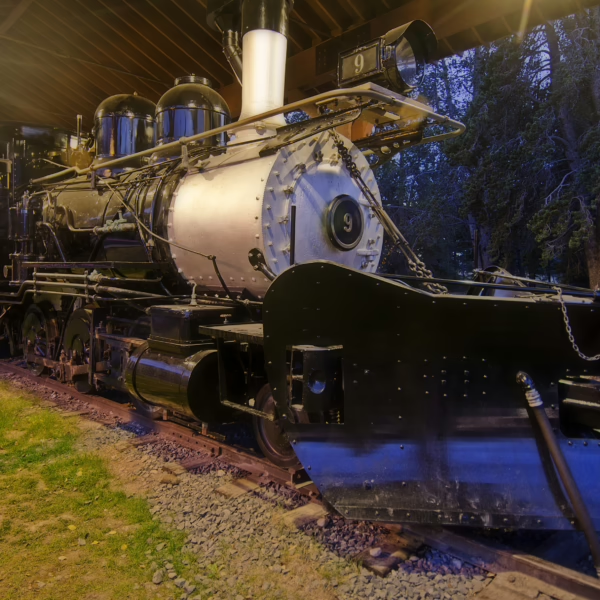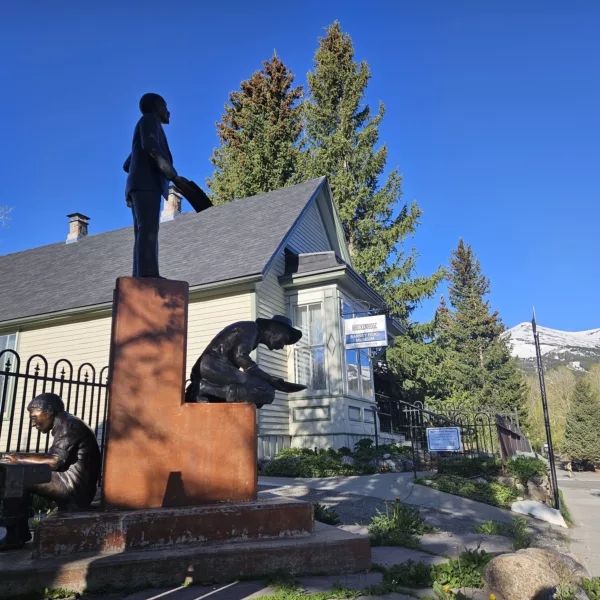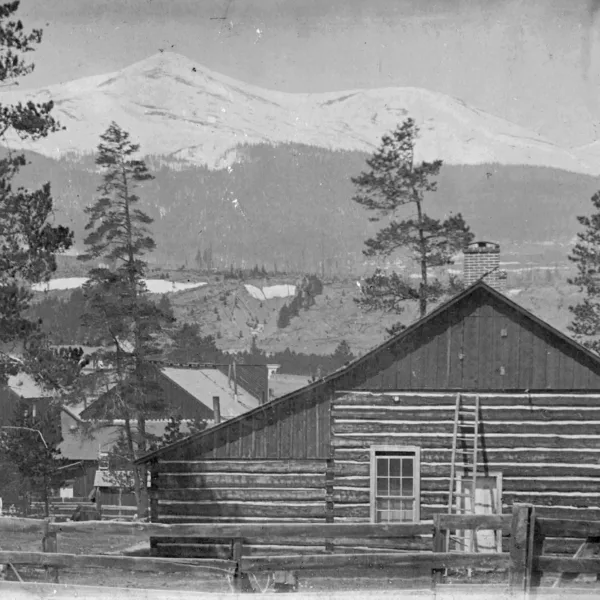Una comunidad enterrada: Cementerio histórico Valley Brook de Breckenridge
04 octubre 2021 | Category: Hacer historia

Un cementerio comparte las historias de su comunidad. Desde alfareros a ciudadanos prominentes, epidemias y accidentes, aumentos y descensos de población, alianzas y enemigos, tendencias y anécdotas se cuentan en el histórico cementerio Valley Brook de Breckenridge. Conozca la historia de Breckenridge revelada en las tumbas de quienes la vivieron en un recorrido a pie por el cementerio con la Alianza del Patrimonio de Breckenridge.
Valley Brook refleja Breckenridge, antes y ahora. Aquí está enterrada una comunidad y sus habitantes cuentan la historia de Breckenridge en sus lápidas, símbolos y ubicación en el cementerio. Valley Brook sigue siendo un cementerio activo, donde el nuevo Breckenridge se mezcla con el antiguo.
El entierro más antiguo data de 1876, cuando el niño Yingling fue enterrado en la sección católica de lo que pronto se convertiría en el cementerio de Valley Brook. Reuniendo tumbas y restos de cementerios dispersos por Breckenridge, Valley Brook comenzó formalmente en 1880 cuando William McAdoo permitió a la creciente comunidad minera establecer su cementerio en su Masonic Placer. Finalmente, en 1896, McAdoo aceptó el pago por los terrenos, consolidando la ubicación permanente del cementerio. Idealmente situado fuera de la ciudad y aguas abajo del suministro de agua, Breckenridgians dio la bienvenida a Valley Brook.
A finales del siglo XIX, la gente de todo Estados Unidos buscaba una experiencia similar a la de un parque para sus cementerios. Para recordar y honrar a los difuntos, los vivos se reunían con picnics en los cementerios. Como resultado, Valley Brook refleja la tendencia de los cementerios como lugares atractivos para pasar el tiempo, ya sea breve o eternamente.
Dispuestas en forma de cruz celta, a las parcelas de Valley Brook se accede por calzadas circulares, callejones y caminos con nombres de flores silvestres y árboles locales. En primavera florecen las primeras pascuas púrpuras, seguidas de abundantes flores silvestres durante todo el verano, creando la sensación de un jardín contemplativo. A la entrada del cementerio se encuentra la casa del sacristán, construida en 1901 para el cuidador de las tumbas. Una elegante señal que se arquea sobre la entrada separa el mundo de los vivos del de los difuntos.
En el cementerio, las lápidas revelan mucho más que nombres, fechas de nacimiento y defunción. Las lápidas hablan de personalidades, pasiones, profesiones y detalles íntimos de la vida. En muchas lápidas se indica la pertenencia a órdenes fraternales, el servicio militar, la afiliación religiosa y las relaciones familiares.
Como en vida, los muertos enterrados en Valley Brook se reúnen con amigos y aliados. Hay varias zonas dedicadas a organizaciones fraternales, como el Gran Ejército de la República, la Tribu Kiowa 6, la Orden Independiente de los Hombres Rojos, la Orden Internacional de Odd Fellows, los Caballeros de las Pitonisas y otras.
Ocupando la gran sección sur, los masones descansan en la mejor propiedad inmobiliaria de Valley Brook. La familia Engle, ciudadanos prominentes con descendientes que aún hoy viven en el condado de Summit, moran en la esquina sureste de la sección masónica. El arroyo Cucumber Creek se precipita suavemente en las cercanías y el lugar es visible para la calzada que pasaba por el cementerio. En lo que hoy llamamos Airport Road, los familiares pasaban en sus carruajes para ver y reconocer a los difuntos. Cerca están los amigos de la familia Engle, los Yust.

En el lado opuesto del cementerio se encuentra Bob Lott, enterrado en la sección de Potter o de los mendigos. No se sabe si Bob era un indigente, pero era un hombre afroamericano, y por lo tanto relegado al Campo del Alfarero. Las normas de la época prohibían la presencia de minorías en el cementerio. Sin embargo, Bob estaba tan bien considerado en Breckenridge que sus amigos encontraron la forma de hacer una excepción. Su lugar de descanso está marcado con una de las pocas lápidas visibles en el campo de los alfareros, que recuerda a Bob como "un ciudadano leal y un amigo fiel".

Muchos niños y bebés están enterrados en Valley Brook. Un moisés de alambre alrededor de una tumba indica que se trata de un bebé. Un cordero sobre una lápida indica que se trata de un niño pequeño. Las epidemias, como la escarlatina y la gripe, se llevaron a muchos niños. Emma Roby y Helen Remine murieron con pocos días de diferencia en la epidemia de difteria de 1897 y están enterradas juntas. Cerca, la lápida de Maggie Remine con las manos entrelazadas indica que fueron amigas para siempre.
La historia de auge y decadencia de Breckenridge se refleja en la parcela de la familia Tressler. James Tressler murió en noviembre de 1897 a la edad de 52 años. Su esposa Louise eligió una parcela que le situaba cerca de otras familias estimadas de la época, como los Footes (Theobald) y los Torkington. Tressler era un comerciante y minero de recursos y la parcela refleja su posición en la comunidad. Rodeado de una elegante verja de hierro, "Papá" James descansa eternamente, ajeno a las tragedias que acaecerían a su familia en los años venideros.
En 1904, el pequeño Jimmie Tressler murió de tos ferina y su madre quedó desolada. Comenzó entonces a liquidar sus bienes, vendiendo concesiones mineras y otras propiedades de la ciudad. En 1905, Louise se volvió a casar, pero el matrimonio no duró. En 1920 aparece de nuevo como la Sra. Tressler, que regentaba pensiones y acogía a niños. En 1928, su hermosa casa se incendió y un niño de acogida de tres años murió en el incendio. La Sra. Tressler, sin un céntimo, pasó sus años en la beneficencia y murió en la pobreza en Breckenridge en 1940 a la edad de 82 años. Su sencilla lápida, una placa de latón montada sobre una roca, sólo menciona su nombre y los años de nacimiento y muerte, utilizando el menor número de caracteres posible para ahorrar dinero. Contrasta con la opulencia de la lápida de su marido James. La historia de la familia Tressler, de riqueza a pérdida y empobrecimiento, no es infrecuente en las comunidades mineras.
En la actualidad, Valley Brook sigue siendo un lugar donde muchos residentes de Breckenridge desean que se les recuerde para siempre, que descansen eternamente en el valle de suave belleza del Upper Blue River.
A Gail, intérprete y docente de la Breckenridge Heritage Alliance, le encanta contar las historias de Breckenridge a través de Valley Brook; "Nuestro cementerio es como la obra de teatro Our Town meets Christmas Carol on Halloween", explica. La visita guiada Tombstone Tales Tour, que suele ofrecerse de junio a octubre, incluye aspectos destacados del cementerio de Valley Brook y de la historia de Breckenridge.
Para saber más sobre la historia de Breckenridge, visita el sitio web de la Alianza del Patrimonio de Breckenridge para leer artículos sobre historia y blogs, visitar un museo o apuntarte a un paseo o excursión guiada.
escrito por Leigh Girvin




